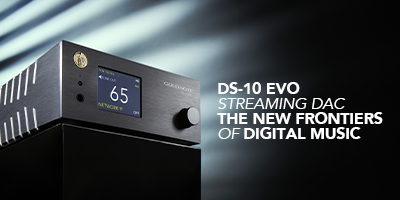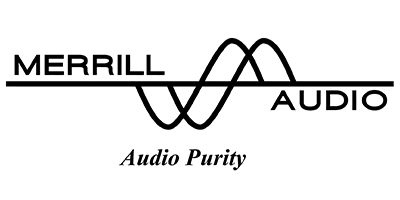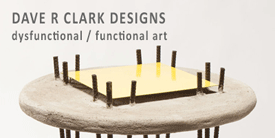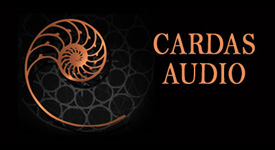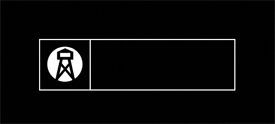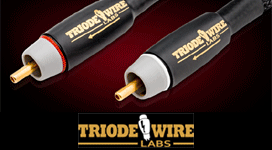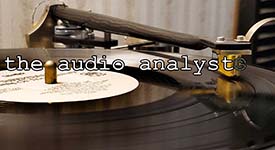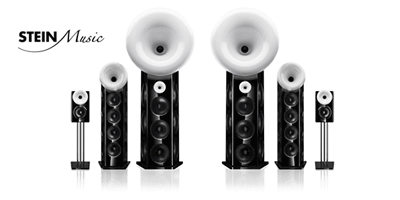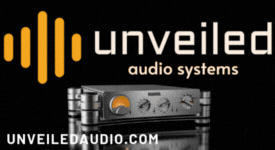My Current System & My Philosophy Toward Audio
My system is fully transformer-coupled, which is probably heresy to many audio circuit designers and engineers; there are no interstage coupling or cathode bypass capacitors anywhere within the entire signal path, from the moving-coil cartridge, to the paper and oil capacitors utilized within the loudspeaker crossover network. In my opinion, and to my ears, nothing beats the musicality, color, vibrancy, purity, and tangibility of transformer coupling when careful circuit design and high-quality audio transformers are used. Others are, of course, certain to disagree.
A total of four triodes in each channel are all that are required to play a record.
My design philosophy stresses simplicity in design as the primary goal, using the minimal number of components to do the job, as each component and the way it is utilized and operated, contributes its own coloration and distortion to the audio signal. But too much simplicity can also stray from the task at hand, and this is where the designer has to be very careful, practicing the ideal balance between the simplest overall circuit topology, and the best possible sound.
My current system (above) consists of the following equipment, with detailed descriptions of several of these components to follow:
My Altec A-5s loudspeakers.
A JBL 4645C cinema subwoofer, driven by a Crown Dsi 2000 Class D amplifier. It crosses over at 55 Hz, and with the JBL B-6 alignment programmed into the Crown DSP, provides 6 dB of boost below 35 Hz, to achieve reasonably flat response down to 22 Hz. As much as I like my A-5 speakers, they drop like a rock below around 50 Hz, and the subwoofer adds the much missing foundation and weight to the music.
My EMT 927A st turntable, with an EMT TSD-15 moving-coil cartridge.
A pair of silver-wire moving coil step-up transformers built to my specifications by Dave Slagle of EMIA. They provide 17 dB of voltage gain, and are terminated into a 300K ohm (not the standard 47K ohm) resistive load.
Moving coil step-up transformers are, in my opinion, the most misunderstood and misused component in all of high-end audio. One of these days, I should write a paper on this subject.
An all-transformer-coupled 2-stage LCR phono preamp, utilizing Lundahl and Sowter magnetics, and designed and built by me. This unit is described in more detail later in this article.
A Transformer Volume Control (TVC), built by me, using the wonderful sounding and now-discontinued Stevens & Billington TX-102 TVCs.
My transformer volume control (TVC) unit was built around 2005 or so. It uses the long-discontinued Stevens & Billington (S & B) TX-102 TVCs.
Unlike the more common "autoformer" TVCs available nowadays, the TX-102s provide full galvanic isolation between their input and output, and they are configured for balanced input/output operation.
A pair of 2-stage transformer-coupled amplifiers, designed and built by me, using an EML mesh-plate 45 driving a single-ended WE-300B, also described later.
The smaller chassis to the right of the power amplifier was added when I modified the design for incorporation of the WE-Ultrapath circuit. It provides additional LC B+ power supply filtering for the 45 driver and WE-300B output stages, which is a requirement when using the Ultrapath circuit to keep power supply hum modulation to an absolute minimum.
The power amplifier power supply unit is the below the amplifier. Note the pair of 83 mercury vapor rectifier tubes, and the 6AX4GT damper diode tubes for graceful application of the high-voltage
Right equipment rack, top to bottom:
2-Stage Transformer-Coupled LCR phono preamplifier (top).
EverSolo DMP-A8 Streamer (middle). This is optically connected to the gigabit LAN port of our ISP-furnished modem-router-switch, and this and the fiber-optic single-mode media converters are powered from linear power supplies. The switching-mode power supply provided by our ISP for use with the modem-router-switch is an electrically noisy piece of junk that ruins the sound of the streaming audio, and it was discarded. More details on this topic will be found later within this article.
A PS Audio Model P12 Power Regenerator (bottom): This provides regenerated and conditioned pure AC power for the entire system.
Left equipment rack, top to bottom:
EMT Model DU 937 Frequency Converter, for converting 60 Hz AC line frequency, to 50 Hz for the EMT 927A st Turntable.
Meridian Model 500 CD transport.
My homebrew Transformer Volume Control (TVC) Unit, using S & B TX-102 TVCs.
Homebrew power supply for my 2-stage transformer-coupled LCR phono preamplifier.
Benchmark DAC 3B DAC.
An Ampex Model 300C-2 stereo 2-track vacuum tube tape recorder, manufactured in 1957, and restored and rebuilt by me in 2001 (above).
An Ampex Model 351-2P stereo 2-track vacuum tube tape recorder, manufactured in 1963, and restored and rebuilt by me in 2002 (above).
The Ampex Model 351-2P 2-track stereo "portable" tape recorder, with vacuum tube electronics. The definition of "portable" in 1963 was quite different from what it is now.
Ampex Model AG-440B-2 2-track stereo solid-state tape recorder, in it's factory roll-around console. The record-reproduce electronics for the Ampex 351-2P recorder can be seen directly below it.
A circa 1957 REL 646C Precedent FM monaural tuner (not shown), a Mitsubishi Model DA-F20 stereo FM tuner (not shown), and a Nems-Clarke Model 1302A Wideband FM tuner (above).
The Nems-Clarke 1302A is an amazing tuner, which I acquired from a fellow ham radio operator. This then state-of-the-art all-vacuum tube unit tunes the frequency range of 65 to 260 Mhz, and was developed in the late 1950s during the height of the cold war for use as a satellite downlink and military surveillance receiver.
It employs a Western Electric 416A planar triode in the RF front end as the first RF amplifier, making it an incredibly sensitive tuner. The FM discriminator/detector stage was designed for extremely good linearity, resulting in a very low level of distortion. It provides a transformer-coupled line-level and balanced 600 ohm audio output.
None of these tuners are currently integrated within my system, as I prefer to get much of my music streamed via the Internet.
My entire system is configured as 600 ohm balanced throughout, which is another benefit of all-transformer coupling. I use Kimber KCAG silver interconnects, Kimber TAK-AG phono interconnects, and Alpha Core Silver speaker cables. I have not changed any of my audio cables in 25 years, as I remain very pleased with their sonic attributes.
I did add Cardas copper audiophile-grade power cables around a year ago, finally giving into the recommendations of a number of my fellow ultra-fi enthusiasts, after borrowing some of these fine-sounding cables to audition.
Although my interconnects and speaker cables are all silver, I am not an advocate of too much silver within my system. High-quality silver wire can certainly provide great clarity, but I find that too much silver deprives the system of warmth, and the use of the silver cables, the silver-wound EMIA moving coil step-up transformers, and the copper wire in all of the other audio transformers within my system, provides a nice balance of warmth, tonality, and clarity.
Several audio enthusiasts have asked how I use the RCA connector-terminated and unshielded Kimber KCAG interconnects as balanced cables. I float the RCA female connectors in all of my equipment above ground, and since the KCAGs are of a twisted-pair configuration, they provide substantial common mode noise rejection when used in balanced service. As such, I don’t need balanced XLR connectors, and I never have any hum or noise pick-up from the interconnects.
What I Value in a High-Quality Audio Reproduction System
The hardware really only exists to do justice to the music, and to play it honestly and realistically. Nothing more, and nothing less.
I need a system that is free of any kind of electronic or mechanical sound. The purity of reproduction and correct tonal balance are my most important criteria, as I cannot tolerate any characteristic of any kind which results in listener fatigue. Excessive brightness and any harshness are non-starters for me.
The second most important attribute I value are rhythm and pace. Music is supposed to be fun and enjoyable to listen to. If you aren’t involuntarily tapping your foot or bobbing your head to music which engenders this kind of activity, something is very wrong. What we really want our stereo systems to be is a great sounding jukebox!
I like a “big”, effortless sound with great clarity, which horn-loaded loudspeakers are typically very good at presenting. Forgive my lack of enthusiasm for small, inefficient “monkey coffin” high-end speakers that may be very good at presenting decent tonality and accurate imaging, etc., but they sound dead to me, with no sense of excitement. This is a sound that fails to make me want to listen for any extended period of time. The foundation to the music, that being the lowest 1-1/2 octaves, has to be there as well, and it has to be reproduced cleanly, with no boom or exaggeration.
I value a large soundstage, along with the portrayal of depth and space, or as I like to say, it has to be “very stereo sounding”. The music has to completely fill the room with a sense of openness and air. But pinpoint imaging accuracy is not a major requirement for me, although I think my system does image very well, and others who have heard it feel much the same way, but this is not something I have strived to improve.
I need a system that makes me want to go downstairs and look forward to firing up the stereo for an extended listening session, instead of watching the television. The technology that makes this happen is irrelevant, just so long as it provides an endless enjoyment of the music I wish to listen to.
To that end, to make this happen, while at the risk of being somewhat redundant, I practice and utilize:
-Highly sensitive horn-loaded loudspeakers.
-All vacuum tube electronics, with directly-heated triodes for the driver and output stages.
-Transformer coupling of every possible gain stage, utilizing the best quality audio transformers available.
-Only enough system gain to provide realistic and satisfying sound pressure levels in the listening space, and that means no line-stage preamps, and only transformer volume controls (TVCs) where possible. Most commercially-made high-end systems have way too much system gain.
-High transconductance/low plate resistance triodes for the gain stages in a high performance/low-noise phono preamplifier.
-Mercury vapor and/or TV damper diodes for high-voltage rectification. Sorry, no 5U4s, GZ-34s, or 5R4GYs. Yes, I used to swear by 5R4GYs at one time, but not any more.
-Polypropylene and oil, or paper in oil decoupling and power supply filter capacitors. No evil-sounding electrolytics anywhere, except for the filtering of DC heater and filament supplies. And forget about the much vaunted and now discontinued Black Gates!
-No negative feedback anywhere.
-LCR-based phono equalization.
-The moving coil step-up transformer must be specifically designed for the optimum matching of the cartridge to the first gain stage of the phono preamp.
-Very pure, noise-free AC for the operation of all of the electronics which comprise the system.
-Balanced interconnections between the different equipment comprising the system.
More details pertaining to many of these requirements will be explored later.
Unrelated to this, what I think we audio enthusiasts really need, are tone controls. They were of course standard equipment on much of the high-quality tube equipment built in the 1950s and 1960s, and they remained on the legions of mid-fi gear that began coming out of Japan in the late 1960s, but they have all but disappeared from virtually all high-end and ultra-fi preamplifiers.
We all know the reason why; tone controls tend to degrade the quality of the reproduction. But aside from the obscenely expensive, wasteful, and frequently obsessive-neurotic way of changing cables, electronics, and speakers, etc., in pursuit of the “perfect” tonal balance, we really have no way of compensating for the skill and taste (or lack thereof) of the recording and mastering engineers, insofar as what they considered to be the ideal tone of a given recording. And this of course can change from track to track, and certainly from one record to another. Perhaps this is one reason as to why Marantz 7s refuse to die.
If someone can develop an outboard equalizer/tone controls that won’t degrade the sonics of the system, yet provide a reasonable adjustment of tone, similar in concept to the highly regarded and now rare Cello Palette, I’m all in. I suspect this will have to be done in the digital domain, and I’m not so sure the present technology for this is quite there yet, in terms of not introducing any perceived digital harshness and distortion, etc.
Please click on the link below to go the next page.

